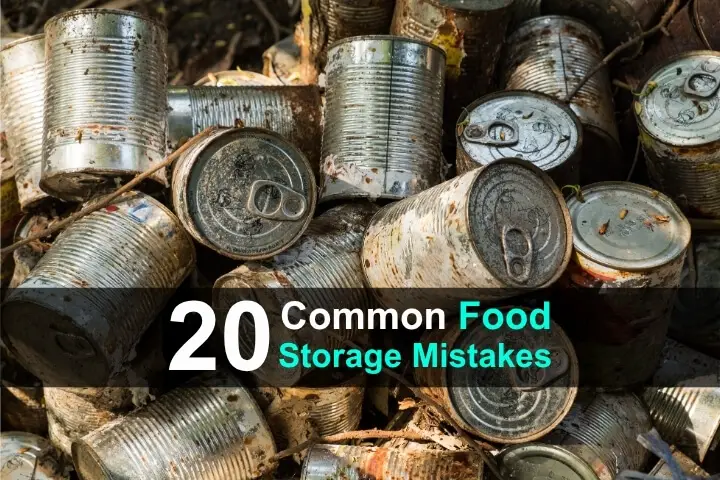
Even experienced preppers make food storage mistakes. I once knew a guy who stored 200 pounds of rice in his closet. Years later, he discovered that every bag was filled with weevils. Why? He skipped one simple step: putting the rice in airtight, pest-proof containers. He thought that since the rice came in sealed bags, it would be fine.
Remember, prepping isn’t a one-and-done task. It’s an ongoing process of learning, adjusting, and improving. No matter how long you’ve been at it, you’re bound to make mistakes every now and then. While most of the mistakes in this list are made by newbies, there are a few that even long-term preppers still make.
I probably could have included dozens of mistakes, but I believe these are the 20 most common food storage mistakes. How many of them have you made?
Want to save this post for later? Click Here to Pin It On Pinterest!
Note: The mistakes in this list are in random order, not by order of importance.
1. Planning to store food, but never doing it
Many people get caught in the planning trap. They research, make lists, and watch videos, but never actually store any food. Planning can feel productive, but unless you take action, it’s meaningless.
The best strategy is to start small. Buy a few extra cans or staples during each grocery trip. The habit of consistent action is far more valuable than a perfect plan that’s never implemented.
2. Buying food and forgetting about it
It’s easy to feel like you’re making progress by purchasing bulk food and tucking it away. But if that food ends up shoved into a corner and forgotten, it will likely expire or spoil.
Food rotation and visibility are key. Keep your food where you can see it, and use what you store. If you want your food to remain hidden, then create a routine where you look everything over and take inventory every week or month.
3. Buying huge quantities of foods you haven’t tried
Never assume you’ll like something just because it’s marketed for preppers. Many long-term storage meals, especially freeze-dried entrees, can taste bland or strange. You don’t want to discover this when you’re already in a crisis.
Always test new foods before buying in bulk. Most emergency food companies will send free or cheap samples if you ask.
4. Buying bulk foods just because they’re on sale
A great deal isn’t great if it ends up in the trash. Buying ten pounds of powdered eggs because they were marked down makes no sense if you won’t eat them.
Make sure every item you buy fits into your meal plan, matches your cooking skills, and aligns with your family’s taste preferences. Budget-conscious prepping is smart, but impulse buying isn’t.
5. Storing food you don’t normally eat
Familiarity is a comfort during stressful times. When your routine is disrupted, eating food that tastes and feels familiar can provide emotional stability. If your family normally eats pasta, rice, and canned chicken, store those things. Emergency food shouldn’t be exotic. It should be an extension of your regular diet.
6. Not having enough variety
Food fatigue is real. Eating the same meal day after day wears people down. Stockpiling 100 pounds of beans might sound efficient, but without other foods to mix things up, you’ll quickly grow sick of them.
Include different proteins, grains, vegetables, and snacks. A mix of textures and flavors keeps spirits up and makes meals feel normal, even in difficult situations.
7. Buying too many foods that require refrigeration
Freezers are great, until the power goes out. If you’re relying heavily on frozen meat, dairy, or meals, you’re vulnerable to blackouts. While frozen foods can be part of your storage plan, they shouldn’t be the backbone of it.
Focus on shelf-stable items like canned meats, freeze-dried meals, and dry goods that can survive without electricity.
8. Only storing foods that are difficult to cook
Raw beans, whole grains, and bulk flours may be affordable, but they often require lots of time, water, and fuel to prepare. In an emergency, you might not have the luxury of long cooking times.
Be sure to also store foods that are simple to prepare in case you want a quick meal. Things like canned goods, instant rice, oatmeal, dehydrated meals, and other low-effort options that conserve energy and resources.
9. Forgetting about spices and condiments
Things like salt, pepper, hot sauce, mustard, oil, vinegar aren’t luxuries. They’re necessities. A bland bowl of rice can become a satisfying meal with the right seasonings.
Don’t overlook the morale-boosting power of flavor. Store your family’s favorite spices and condiments, and consider shelf-stable versions that don’t require refrigeration.
10. Not labeling your food with expiration dates
Unlabeled food is a gamble. You won’t remember when you stored it, which means you’ll either throw it out early or risk eating something unsafe.
Always label with the purchase or best-by date. Use a sharpie, label maker, or masking tape to make it obvious. A few seconds of effort can save money and prevent waste.
11. Not using durable, food-safe containers
Leaving food in original packaging is a huge mistake. This is especially true of cardboard or thin plastic, which leave food vulnerable to pests and moisture.
Instead, transfer food into Mylar bags with oxygen absorbers and store those in food-grade buckets with tight-fitting lids. For smaller items, use mason jars or vacuum-sealed bags. Protect your investment with the right containers.
12. Storing food in places with moisture and temperature swings
Temperature and humidity are enemies of food storage. Hot garages, damp basements, or attics that freeze and bake with the seasons will shorten shelf life and attract pests.
The best storage area is dark and about 50–70°F with low humidity. If that’s not possible, consider a dehumidifier or even building a dedicated storage closet inside your home.
13. Not rotating your food
Preppers often fall into the trap of hoarding instead of rotating. Set up a rotation system using the first in first out method. Use older items before newer ones. Store new food at the back and bring older food forward. This ensures nothing expires before you get to it.
14. Not having an inventory list
If you don’t know what you have, you’ll end up buying duplicates or forgetting to replace crucial items.
Keep a simple spreadsheet, a notebook, or use an app to track your supplies. Review it regularly to plan shopping trips and identify gaps in your stockpile. A little organization goes a long way.
15. Not having the tools to prepare your food
A pantry full of canned food won’t help if you don’t have a can opener. Likewise, storing wheat is useless without a hand grinder.
Consider the tools your stored food requires and make sure you have non-electric versions: a manual can opener, camp stove, pots, water filter, and utensils. Be sure to test everything before you need it.
16. Not protecting food from light exposure
Many people focus on temperature and humidity but forget that light can degrade food over time. And not just sunlight. Even clear containers or jars stored in a bright pantry can suffer from nutrient loss and flavor changes.
To preserve shelf life and nutritional value, store food in opaque containers or in a dark, enclosed space. Mylar bags help block light, and food-grade buckets can be stacked in closets, under beds, or in low-light storage rooms. Keeping your food in the dark is a small habit that makes a big difference.
17. Ignoring nutritional diversity
Caloric needs are important, but vitamins and minerals are just as vital. Living off white rice and peanut butter can lead to deficiencies. Be sure to include canned vegetables, tomato products, dried fruits, and shelf-stable greens. A multivitamin or vitamin C supplement can help fill any gaps in your stockpile.
18. Storing food in unsafe containers
Not all containers are safe for food. Garbage bags, old buckets, or mystery plastics may leach toxins or allow air and moisture in. Only use food-grade containers, and avoid reusing old packaging unless you’re sure it’s safe. Your health is worth a few extra bucks.
19. Not having a backup cooking method
Don’t assume your stove will be available when disaster strikes. Power outages, gas shortages, or evacuation can all make your kitchen unusable. A propane stove, campfire grill, or rocket stove can save the day.
Make sure you also have enough fuel and cookware to go with it, and practice using it before an emergency happens.
20. Never testing your food in real-life scenarios
Many preppers store food they’ve never actually cooked. In theory, everything looks fine. But in practice, it could taste bad, take forever to prepare, or require gear you don’t have.
Do a trial run: cook a week’s worth of meals using only your storage food and emergency tools. It’s the best way to uncover problems before they become dangerous.
Like this post? Don’t Forget to Pin It On Pinterest!
You May Also Like:
Read the full article here





